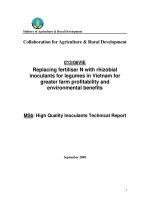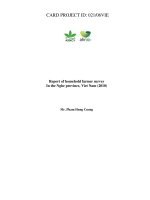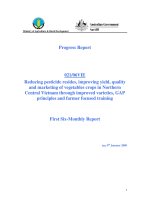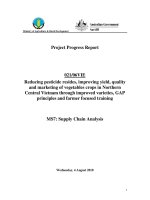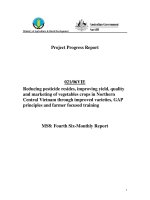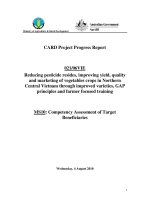Báo cáo khoa học nông nghiệp " POST HARVEST MANAGEMENT AND NEW APPROACH FOR SUPPLY CHAIN SYSTEM OF CABBAGE AND WATER MELON " doc
Bạn đang xem bản rút gọn của tài liệu. Xem và tải ngay bản đầy đủ của tài liệu tại đây (215.62 KB, 5 trang )
1
POST HARVEST MANAGEMENT AND NEW APPROACH FOR SUPPLY CHAIN
SYSTEM OF CABBAGE AND WATER MELON
Presenter: Nguyen Tuan Minh M.Sc.
Fruit and Vegetable Research Institute, FAVRI
I. Introduction
Vegetables play a significant role for farmers as large number of rural household have been
involved in vegetable production and trade. However, Vietnam is actually faced with a number
of post-harvest problems particularly as vegetable production has been increasing fast over the
last decade. The post-harvest losses are still very high with 25-30% in average due to weakness
in post-harvest technology.
Even with high labour inputs in vegetable production, income of farmers is still low. Profit at
down-stream stages of supply chains is also low for other actors’ who are involved in
distribution, transportation and trading of vegetable products. There are several possible
explanation: one of them is high qualitative and quantitative losses of fresh vegetable during
passage through supply chains due to lack of facilities and proper handling methods. It also
causes food quality and safety problems due to the use of improper care.
Post-harvest losses can occur during harvesting in the field, in packing areas, in storage, during
transportation and in the wholesale and retail market. Severe losses occur because of poor
facilities, lack of know-how, poor management, market dysfunction or lack of knowledge by
farmers. On September 2009, long and heavy rain in Quynh Luu, Nghe An caused high spoilage
rate of water melon and shorten the self life of the produce.
Utilizing improved post-harvest practices (e.g. adequate harvesting, handling and treatment
methods, packaging, proper transport and marketing) often results in reduced food losses,
improved overall quality and food safety, and higher profits for growers and marketers.
Objective:
- To find out proper post-harvest management and new approach for modern supply chain for
cabbage and water melon.
II. Materials and research methods
1. Materials, location and timing:
- Cabbage grown in Quynh Luu, Nghe An on winter-spring season in 2009
- Water melon grown in Quynh Luu, Nghe An on summer in 2009
- Chemical treatment: alum, lime, chlorine
- Instruments: technical scale, tempe. loggers.
2
2. Methodology
+ Supply chains mapping
- Cabbage and water melon delivered from Quynh Luu to Hanoi by truck, temperature loggers
were put in several locations in current containers and in different position in truck. Current
containers for cabbage transportation are jute bags. Some containers tested were carton with
windows and wood box with soft filters. For water melon, they were put directly on floor of
truck with dried straw. Tested containers were cartons with window with dried straw.
+ Post harvest treatment
- Cabbage were treated with saturated lime and 15% alum and control
- Water melon treated with chlorine solution 100 and 150ppm and control
+ Analysis
Spoilage rate were calculated by the ration between spoilage part per total sample for cabbage,
and total fruits per total sample for water melon.
III. Result and discussion
3.1.Supply chain mapping for cabbage and water melon
After harvesting, cabbage and water melon are often collected and transported during the night
of that day by truck in order to have cool air circulation, not get in stuck. In the next early
morning, commodities are at the wholesale markets or in Supermarkets in Hanoi as orders.
Figure 1: Temperature mapping during the journey of cabbage from Nghe An to Hanoi
Cabbages were delivered by using jute bags and put directly on truck floor. Temperature
decreased gradually during transportation, from 31
0
C to 26
0
C (figure 1). Different location had
3
the same trend, but the temperature were little bit different. In general, without cool transport
means, delivery at night is good way to maintain low temperature.
Water melons were delivered during the night without packing containers and they were placed
directly on truck floor with dried straw for filters. Similarlly, temperature decreased steadily
from 32
0
C to 28
0
C(figure 2).
Figure 2: Mapping temperature during journey from Nghe An to Hanoi for water melon
3.2. Spoilage rate during transportation
Table 1: Spoilage of cabbage during transportation
In Hanoi, spoilage rate in jute bag was the highest with 3.7% compared to 2 other containers. It
is thought that cabbage in jute bag had mechanical damage due to high loading and vibration.
That also caused the problem after 5 days of harvest, the spoilage in jute bag (8.6%) was twice
higher than in wood box and nearly 4 time higher in carton box.
Spoilage rate (%)
In Hanoi After 5 days
Carton used for
transportation
1.1 2.2
Wood box 2.5 3.4
Jute bag (control) 3.7 8.6
4
Table 2: Spoilage rate of water melon during transportation
Mechanical injury was high (3.5%) due to place water melon directly on truck floor with straw.
It is believed that vibration and impact of high bulk load resulted in damage. Carton box for
packing helps to reduce damage during the transportation, especially after 7 days of keeping, the
spoilage rate (1.8%) occurred lower than in bulk load (6.4%).
3.3. Postharvest treatment
Cabbages are often decayed in butts after harvesting. To control that spoilage, some experiments
were carried out. Brush with 15% alum solution or saturated lime on the butt after trimming.
Table 3: Postharvest treatment for cabbage
The table 3 shows that saturated lime can control effectively the diseases. Spoilage in alum
treatment (3.4%) also was much lower than in control (19.0%).
Table 4: Postharvest treatment for water melon
There are bacteria and fungus spores on the surface of water melon that could cause postharvest
spoilage.
Chlorine treatment after 10 days of harvesting reduced the spoilage rate to 0.8-1.1% while the
control had high spoilage rate with 7.2%.
IV. Conclusion and suggestion
1. Proper packing had a positive effect on spoilage reduction. Postharvest treatments (lime or
alum for cabbage and chlorine for water melon) reduced spoilage significantly.
Mechanical damage of spoilage rate (%)
In Hanoi After 7 days
carton 0.5 1.8
No transport packing 3.5 6.4
Spoilage (%) after 6 days
Control 19.0
Alum 15% 3.4
Lime 0
Spoilage (%) after 10 days
Control 7.2
Chlorine 100ppm 1.1
Chlorine 150ppm 0.8
5
2. A post harvest handbook and TOT/FFS training courses need to be taken place to upgrade
knowledge of stakeholders.
3. A new approach for modern supply chain could be proposed to apply for cabbage and water
melon to meet market requirement and consumer demand for higher food quality and safety:
- Supply chain should be adequately simple, flexible, more direct, straightforward and well
coordinated to meet the value and competitiveness of produce.
- Business linkages to promote collaboration and information exchange among
stakeholders.
- Linkages from farm to table can be established through chain traceability systems
(document system and mechanism to marking and identifying the produce records kept
every step of horticultural chain in the field, packing house, suppliers, retailers…).
- Each stakeholder has a defined scope, clear goals and enables the next chain member to
fulfill subsequent activities.
- Participants have to long-term strategic vision to change conventional methods to meet
the increasing demand of consumers.
- Recognize their dependence on each other and willing to work together to define
common objectives, share risks and benefits and make the relationship work.
- Proper handling and temperature management, speed in delivery to next stages.
- A shared commitment to control produce quality and consistency.
- Encourage cooperatives, contracted stakeholders to facilitate time delivery, lower risk of
over production, low production cost of inputs, more knowledge to farmers thanks to
share experience, better communication and technique access.
- High level of confidence in each other that allows greater security in business and
facilitates the development of common goals.
Reference:
Kanlayanarat S., R. Rolle and A. Acedo, 2009. Horticultural Chain Management for Countries of
Asia and the Pacific Region/ A training package. FAO-RAP publication 2009/06.
Bautista O. and E.B. Esguerra, 2007. Postharvest technology for Southeast Asian perishable
Crops. 2 edition, University of the Philippines Los Banos.

